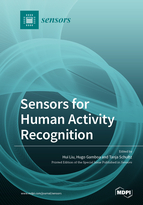Sensors for Human Activity Recognition
A special issue of Sensors (ISSN 1424-8220). This special issue belongs to the section "Sensor Networks".
Deadline for manuscript submissions: closed (30 September 2022) | Viewed by 29327
Special Issue Editors
Interests: biosignal processing; feature selection and feature space reduction; human activity recognition; real-time recognition systems; knee bandage; machine learning
Special Issues, Collections and Topics in MDPI journals
Interests: instrumentation; signal processing; machine learning, human activity recognition (HAR)
Special Issues, Collections and Topics in MDPI journals
Interests: biosignal processing; human-centered man–machine interfaces; user states and traits modeling; machine learning; interfaces based on muscle and brain activities; automatic speech recognition; silent speech interfaces; brain interfaces
Special Issues, Collections and Topics in MDPI journals
Special Issue Information
Dear Colleagues,
The Special Issue "Sensors for Human Activity Recognition II" is online and welcome for your further contribution!
Human activity recognition (HAR) has been playing an increasingly important role in the digital age.
High-quality sensory observations applicable to recognizing users' activities, whether through external or internal (wearable) sensing technology, are inseparable from sensors' sophisticated design and appropriate application.
Having been studied and verified adequately, traditional sensors suitable for human activity recognition—such as external sensors for smart homes, optical sensors like cameras for capturing video signals, and bioelectrical and biomechanical sensors for wearable applications—continue to be researched in-depth for more effective and efficient usage, among which specific areas of life facilitated by sensor-based HAR have been continuously increasing.
Meanwhile, innovative sensor research for HAR is also very active in the academic community, including brand new types of sensors appropriate for HAR, new designs and applications of the above-mentioned traditional sensors, and the introduction of non-traditional HAR-related sensor types into HAR tasks, among others.
This Special Issue aims to provide researchers in related fields a platform to demonstrate their unique insights and late-breaking achievements, encouraging authors to submit their state-of-the-art research and contributions about sensors for HAR.
The main topics for this Issue include, but are not limited to:
- Sensor design and development.
- Embedded signal processing.
- Biosignal instrumentation.
- Mobile sensing and mobile-phone-based signal processing.
- Wearable sensors and body sensor networks.
- Printable sensors.
- Implants.
- Behavior recognition.
- Applications to health care, sports, edutainment, and others.
- Sensor-based machine learning.
Dr. Hui Liu
Prof. Dr. Hugo Gamboa
Prof. Dr. Tanja Schultz
Guest Editors
Manuscript Submission Information
Manuscripts should be submitted online at www.mdpi.com by registering and logging in to this website. Once you are registered, click here to go to the submission form. Manuscripts can be submitted until the deadline. All submissions that pass pre-check are peer-reviewed. Accepted papers will be published continuously in the journal (as soon as accepted) and will be listed together on the special issue website. Research articles, review articles as well as short communications are invited. For planned papers, a title and short abstract (about 100 words) can be sent to the Editorial Office for announcement on this website.
Submitted manuscripts should not have been published previously, nor be under consideration for publication elsewhere (except conference proceedings papers). All manuscripts are thoroughly refereed through a single-blind peer-review process. A guide for authors and other relevant information for submission of manuscripts is available on the Instructions for Authors page. Sensors is an international peer-reviewed open access semimonthly journal published by MDPI.
Please visit the Instructions for Authors page before submitting a manuscript. The Article Processing Charge (APC) for publication in this open access journal is 2600 CHF (Swiss Francs). Submitted papers should be well formatted and use good English. Authors may use MDPI's English editing service prior to publication or during author revisions.









